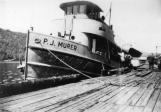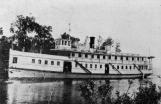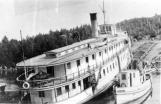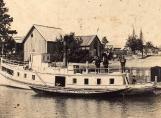8
In the late 1800's, there were several types of steamboats regularly plying Lake Temiskaming. One type of steamer was the tugboat.The Lady Minto was the second-largest tugboat to work on the lake and measured 138 feet in length (the largest was the Alexandria).
The Lady Minto operated on Lake Temiskaming for 65 years, from1903-1968, and in that time, towed booms of logs down the lake.
The tug was able to accommodate 12 crew members who worked six-hour shifts. The living conditions were considered "comfortable" as there was a cook, kitchen, and sleeping quarters on board.
On the trip south on the lake, large tugs like the Minto would tow three booms of logs at a time (also called a "sack") containing as many as 200,000 logs. With 1500 feet of cable holding a mile-long boom together, there was always the threat of a boom breaking up in poor weather conditions and the logs scattering all over the lake.
On the return trip north, the tug would bring back boom timbers or "sticks" and haul up to 70 tons of coal that was placed on a scow and towed in between the timbers. The coal would be used to fuel the boats at the north end of the lake.
The Minto was also the longest operating and the last steamboat to work the lake. In 1968, the boat was burned and sunk to serve as an anchor for a boom.
9
Small Tugs1900
Lake Temiskaming, Ontario, Canada
 Credits:
Credits:Temiskaming Shores Public Library Archives
10
Smaller tugs were used for delivering supplies along the lakes and rivers because they could operate in Lake Temiskaming's shallower tributaries not accessible to the larger tugs.The maneuverability of these boats also allowed them to conduct sweeping operations where logs that escaped from booms being towed on the lake, could be gathered along the shoreline. Tugs like the Wabis and the Ella were sometimes used to pull the floating bunkhouses of the sweep gangs around the lake.
11
The P.J. Murer was a diesel tug1900
Lake Temiskaming, Ontario, Canada
 Credits:
Credits:Temiskaming Shores Public Library Archives
12
The P.J. Murer was a diesel tug that went on to replace boats like the Lady Minto and the Alexandria as the main tugboat on the lake. The P.J. Murer was able to perform the same duties as the steam-powered boats, but in a more economical and efficient manner and with a smaller crew.13
The Steamer "Meteor"1910
Lake Temiskaming, Ontario, Canada
 Credits:
Credits:Agricultural Temiskaming, 1910
14
Passenger boats were really put into service in the 1890's, ferrying settlers from Gordon Creek (now South Temiscamingue) to the town sites of Haileybury and New Liskeard on the Ontario shore, and Ville Marie on the Quebec side of the lake.The Meteor started out life as La Minerve but on March 6th, 1888, it was purchased by Alex Lumsden of the Lumsden Steamboat Line. After being rebuilt several times, the Meteor became one of the best-known and most comfortable boats on the lake.
The earliest settlers took great pride in the fact that they had arrived in the Little Clay Belt on the Meteor, as it signified that they were among the original pioneers to the area. This ship, and others like it, was responsible for bringing the new settlers, mail, freight, and tourists to the area. Before the railway and roads were built to connect the south to "New Ontario", as it was known, it was the passenger boats that served as the lifelines for the communities along the shores of Lake Temiskaming.
15
The Meteor1905
Lake Temiskaming, Ontario, Canada
 Credits:
Credits:Temiskaming Shores Public Library Archives
16
As one of several passenger ships on the lake, the Meteor was by far the most impressive, with three decks and measuring in at 130.5 feet in length and 29 feet wide after being renovated in 1897. The Meteor was given the lofty title of a "Palace Steamer" and according to a 1908 timetable, it was listed as a "first-class passenger steamer and is equipped with all modern conveniences to ensure comfort to passengers. Meals and refreshments served on board. State rooms can be had on application" - The Age of Steam on Lake Temiskaming by Bruce W. Taylor, c.1993Some of these "modern conveniences" included electric lighting, first and second-class dining rooms, a reception room, a card room, and a salon.
When boats were in need of repair, they could be winched out of the water at Moore's Cove, near Haileybury, where the Department of Public Works had a shipyard. In the case of larger boats, such as the Meteor, shown in this picture, they sometimes needed assistance from smaller boats. An "alligator", or a boat with a winch system on it, could be used to help pull a larger boat out of the water and onto shore. In this picture, the tugboat, Scotsman is alongside the Meteor.
17
Note the "Pointer" in the foreground1900
Lake Temiskaming, Ontario, Canada
 Credits:
Credits:Temiskaming Shores Public Library Archives
18
Smaller work boats called "pointers" were used for unloading people and freight from the larger passenger boats that were unable, due to seasonal low water levels, to get close enough to the shore or government docks, for passengers to properly disembark.The larger livestock that settlers brought with them on the boats were not afforded the luxury of a boat in these circumstances, and were often pushed out of the ship's freight door and into the lake where they then had to swim for shore!
Smaller steam launches like the Blanche and the Geisha were used to carry passengers up the Blanche River to settle in the townships north and west of the New Liskeard town site and continued to operate as mail and freight carriers into the less accessible farming areas.
19
The importance of the steamships on the lake lessened over time. With the introduction of the railway into the area in 1905, and then the construction of the Ferguson Highway linking the Clay Belt to southern Ontario in 1927, the days of the passenger steamship were numbered.20
The railway with its steam engines, and later diesel-powered engines, could operate year-round, and became the preferred mode of transportation. The more utilitarian boats like the tugs and other small vessels were able to survive as important tools in the lumber industry until the 1960's when lumber in the area declined.21
Bruce W. Taylor, local authorCirca 1993
New Liskeard, Ontario, Canada
 Credits:
Credits:The Age of Steam on Lake Temiskaming